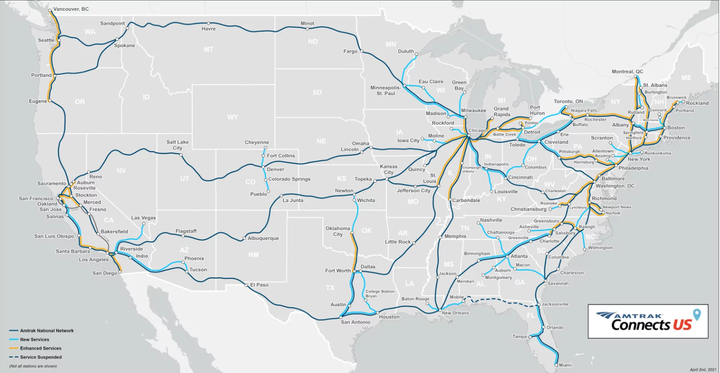The largest federal investment in the nation’s infrastructure in decades includes no dedicated funding for high-speed rail, once a top transportation priority in the White House.
The omission reflects how the issue of high-speed rail has largely disappeared from the policy debate in Washington.
In 2011, President Barack Obama called for giving 80% of Americans access to high-speed rail within 25 years. The lofty goal was quickly shelved after Republican objections to federal spending. Today, there’s only one true high-speed rail project in the works, in central California, but it’s been set back by lengthy permitting delays and huge cost overruns.
The Senate is expected to approve legislation this week that includes $1.2 trillion in spending aimed at modernizing the nation’s roads, bridges, airports, railways and waterways. It’s a major bipartisan achievement for Congress and for President Joe Biden, an avid train fan who often commuted to work in Washington, D.C., from his home state of Delaware, and who campaigned on the issue prior to taking office in January.

“Imagine what we can do, what’s within our reach, when we modernize those highways,” Biden said at an event in March intended to highlight his infrastructure plan. “You and your family could travel coast to coast without a single tank of gas on board a high-speed train.”
But that vision, which is already a reality in some European and Asian countries, is a long way from realization in the United States.
The Senate bill provides $66 billion for intercity rail programs, which the White House calls the “largest investment in passenger rail since the creation of Amtrak 50 years ago.” The funding would go toward improving and expanding existing rail infrastructure, especially in the Northeast Corridor, which is among the highest-volume rail corridors in the world. That means addressing glaring inadequacies in the outdated Amtrak system, fixing bottlenecks to reduce trip length, connecting new cities in both urban and rural areas and improving passenger safety.
Still, transit advocates are holding out hope that Congress will do more, even as they welcomed the bill and urged lawmakers to send it to the president’s desk. That includes boosting construction of new, high-profile rail projects connecting Dallas to Houston or Los Angeles to Las Vegas. The hope is that these projects, once completed, would influence the public’s perception of high-speed rail and increase demand for it nationwide.
“It’s a good start,” said Rick Harnish, executive director of the advocacy group High Speed Rail Alliance. “We’re glad it’s moving forward and want to see it get passed, but it is missing the high-speed component.”
Today’s fastest trains operate at 220 mph and are capable of carrying passengers long distances in a short amount of time. China recently unveiled a new maglev bullet train that can reach speeds of 370 miles per hour. The fastest train in the U.S., the Acela Express, runs at speeds of up to 150 miles per hour. But because of the geography and population density of the Northeast, Amtrak’s fastest train isn’t able to hit its maximum speed often.
The funding in the Senate bill, which was the product of a bipartisan compromise, would help Amtrak cut down trip length by making improvements to existing services. Those improvements would make a substantial difference for commuters even if they don’t technically qualify as “high-speed,” Sen. Chris Murphy (D-Conn.) argued.
“In the Northeast, we don’t need to get high-speed times in order to have a transformational impact on commuters,” Murphy said. “If you ultimately cut travel time from Boston to D.C. by two hours, that’s a huge improvement regardless of whether that’s high-speed or not.”

But other rail advocates view the Senate’s infrastructure bill as a big missed opportunity, one whose provisions are the result of an outdated mindset on transportation that harks back to the days of President Dwight Eisenhower and the Interstate Highway System. These advocates want Democrats to include even more transportation funding in the upcoming $3.5 trillion “human” infrastructure package.
“It’s 1950s transportation policy,” Rep. Seth Moulton (D-Mass.) told HuffPost when asked about the bipartisan bill. “There’s no other country that builds highways and airways and never even considers high-speed rail as an option. That’s because of the policy of Washington, D.C.”
Moulton, who earlier this year proposed spending $205 billion over five years to build out a high-speed rail network in the U.S., said the funding in the Senate bill set aside for the Northeast Corridor is “not even close to enough” to address the needs there.
“NEC could just repair what we have and still have very slow trains, or we could build true high-speed rail and have much better return on investment,” he said.
There’s another reason the U.S. lags behind the rest of the world when it comes to high-speed rail: It simply costs more to build new infrastructure projects here than it does almost anywhere else. There’s no agreement among experts as to why that’s the case. Various theories attribute it to how and where Americans build, the cost of unionized labor, environmental permitting and partisan politicking.
Whatever the reason, it has made more ambitious infrastructure projects like high-speed rail harder to approve and build, as seen in California with its badly delayed and now scaled-down high-speed rail project. But officials there could still receive some federal funding from the new Senate bill ― funding that will ultimately be distributed by Transportation Secretary Pete Buttigieg, a high-speed rail aficionado himself.

“This is a once-in-a-lifetime investment in rail,” Melissa Figueroa, a spokesperson for California’s high-speed rail authority, said last week. “We see somewhere between $20-30 billion in funding we can compete in to get funds for the California high-speed rail project, and that’s what we intend to do.”
It’s possible that Democrats will include more transportation funding in their $3.5 trillion reconciliation package, which they plan to pass without Republican support in the coming months. The budget resolution they unveiled Monday, which serves as an outline for the bill, calls for $35 billion in new transportation spending, on top of the $550 billion included in the bipartisan Senate bill.
“It’s the first step, but we need to do more, and I’m hopeful we will do more in reconciliation,” Sen. Richard Blumenthal (D-Conn.) said when asked about rail funding.
Still, it’s hard to see the investments included in either infrastructure bill leading to high-speed rail on a national level ― and certainly not “coast-to-coast” as Biden spoke wistfully of earlier this year.

